Cross-Cultural Management: US-China Negotiation Analysis
VerifiedAdded on 2023/06/06
|6
|1182
|118
Report
AI Summary
This report delves into the complexities of cross-cultural management, specifically focusing on the dynamics of negotiation between the United States and China. The introduction highlights the importance of communication and ethics in international business, setting the stage for an examination of the differing cultural contexts. The report identifies the issue of ethically questionable tactics employed by China in negotiations, contrasting it with the US approach. It analyzes the issue using relevant literature and theories, including intercultural communication and Hofstede's cultural dimensions (power distance, individualism, masculinity, uncertainty avoidance, and long-term orientation), to explain the underlying cultural variables influencing negotiation styles. The analysis highlights how these dimensions impact communication, attitudes, and negotiation strategies. The conclusion emphasizes the critical role of culture in communication and offers recommendations, such as building value in negotiation and improving preparation, to foster more effective and ethical cross-cultural business practices. The report also provides a comprehensive reference list supporting the analysis.
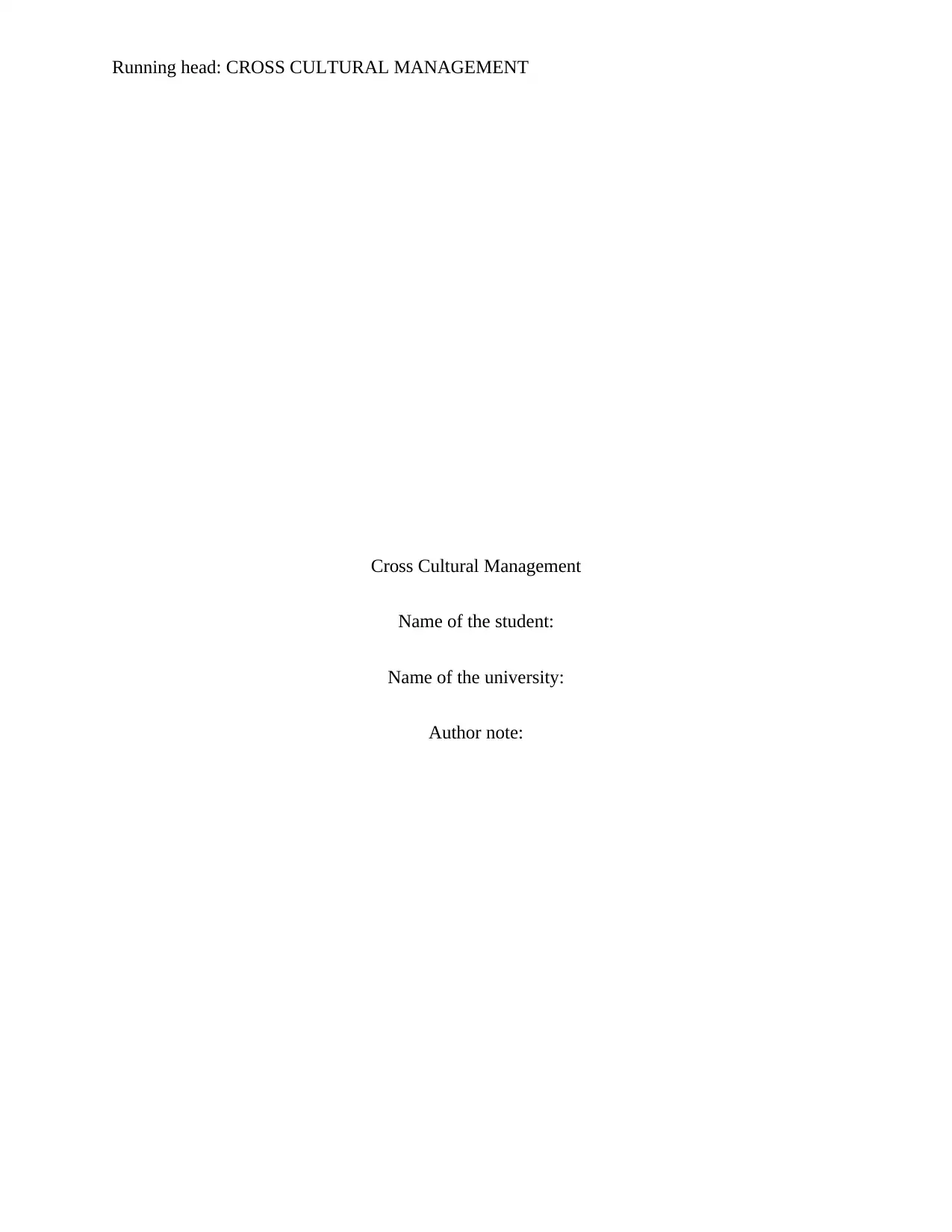
Running head: CROSS CULTURAL MANAGEMENT
Cross Cultural Management
Name of the student:
Name of the university:
Author note:
Cross Cultural Management
Name of the student:
Name of the university:
Author note:
Paraphrase This Document
Need a fresh take? Get an instant paraphrase of this document with our AI Paraphraser
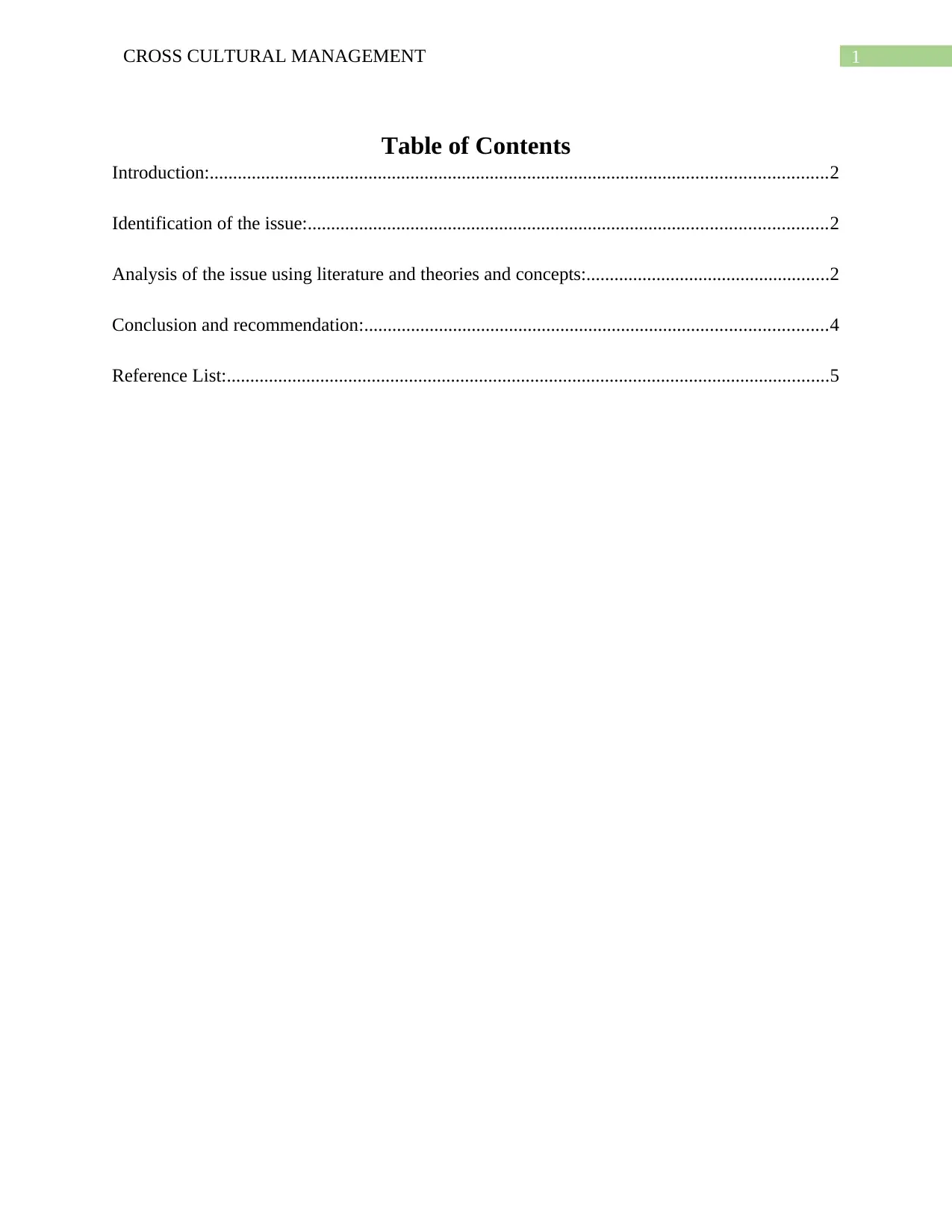
1CROSS CULTURAL MANAGEMENT
Table of Contents
Introduction:....................................................................................................................................2
Identification of the issue:...............................................................................................................2
Analysis of the issue using literature and theories and concepts:....................................................2
Conclusion and recommendation:...................................................................................................4
Reference List:.................................................................................................................................5
Table of Contents
Introduction:....................................................................................................................................2
Identification of the issue:...............................................................................................................2
Analysis of the issue using literature and theories and concepts:....................................................2
Conclusion and recommendation:...................................................................................................4
Reference List:.................................................................................................................................5
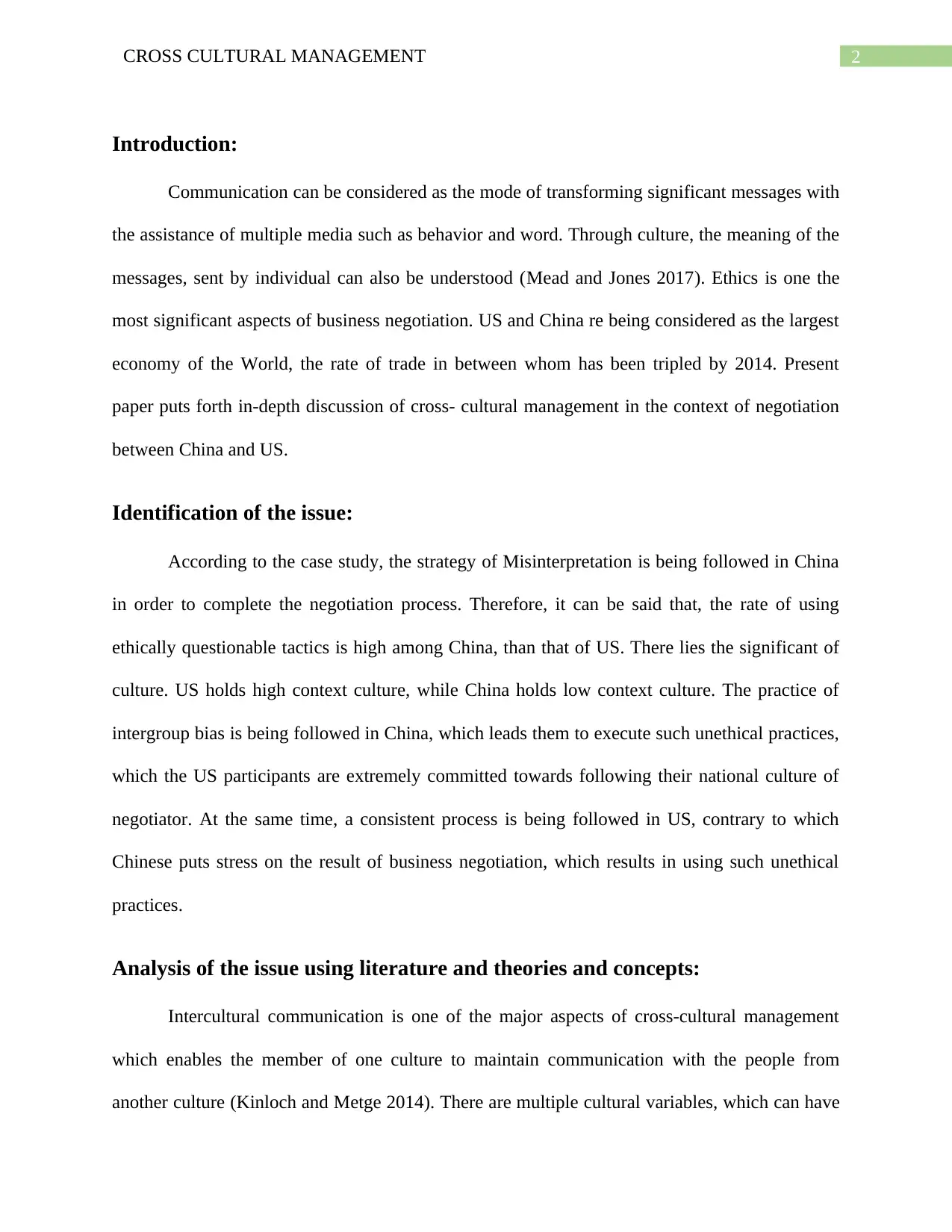
2CROSS CULTURAL MANAGEMENT
Introduction:
Communication can be considered as the mode of transforming significant messages with
the assistance of multiple media such as behavior and word. Through culture, the meaning of the
messages, sent by individual can also be understood (Mead and Jones 2017). Ethics is one the
most significant aspects of business negotiation. US and China re being considered as the largest
economy of the World, the rate of trade in between whom has been tripled by 2014. Present
paper puts forth in-depth discussion of cross- cultural management in the context of negotiation
between China and US.
Identification of the issue:
According to the case study, the strategy of Misinterpretation is being followed in China
in order to complete the negotiation process. Therefore, it can be said that, the rate of using
ethically questionable tactics is high among China, than that of US. There lies the significant of
culture. US holds high context culture, while China holds low context culture. The practice of
intergroup bias is being followed in China, which leads them to execute such unethical practices,
which the US participants are extremely committed towards following their national culture of
negotiator. At the same time, a consistent process is being followed in US, contrary to which
Chinese puts stress on the result of business negotiation, which results in using such unethical
practices.
Analysis of the issue using literature and theories and concepts:
Intercultural communication is one of the major aspects of cross-cultural management
which enables the member of one culture to maintain communication with the people from
another culture (Kinloch and Metge 2014). There are multiple cultural variables, which can have
Introduction:
Communication can be considered as the mode of transforming significant messages with
the assistance of multiple media such as behavior and word. Through culture, the meaning of the
messages, sent by individual can also be understood (Mead and Jones 2017). Ethics is one the
most significant aspects of business negotiation. US and China re being considered as the largest
economy of the World, the rate of trade in between whom has been tripled by 2014. Present
paper puts forth in-depth discussion of cross- cultural management in the context of negotiation
between China and US.
Identification of the issue:
According to the case study, the strategy of Misinterpretation is being followed in China
in order to complete the negotiation process. Therefore, it can be said that, the rate of using
ethically questionable tactics is high among China, than that of US. There lies the significant of
culture. US holds high context culture, while China holds low context culture. The practice of
intergroup bias is being followed in China, which leads them to execute such unethical practices,
which the US participants are extremely committed towards following their national culture of
negotiator. At the same time, a consistent process is being followed in US, contrary to which
Chinese puts stress on the result of business negotiation, which results in using such unethical
practices.
Analysis of the issue using literature and theories and concepts:
Intercultural communication is one of the major aspects of cross-cultural management
which enables the member of one culture to maintain communication with the people from
another culture (Kinloch and Metge 2014). There are multiple cultural variables, which can have
⊘ This is a preview!⊘
Do you want full access?
Subscribe today to unlock all pages.

Trusted by 1+ million students worldwide
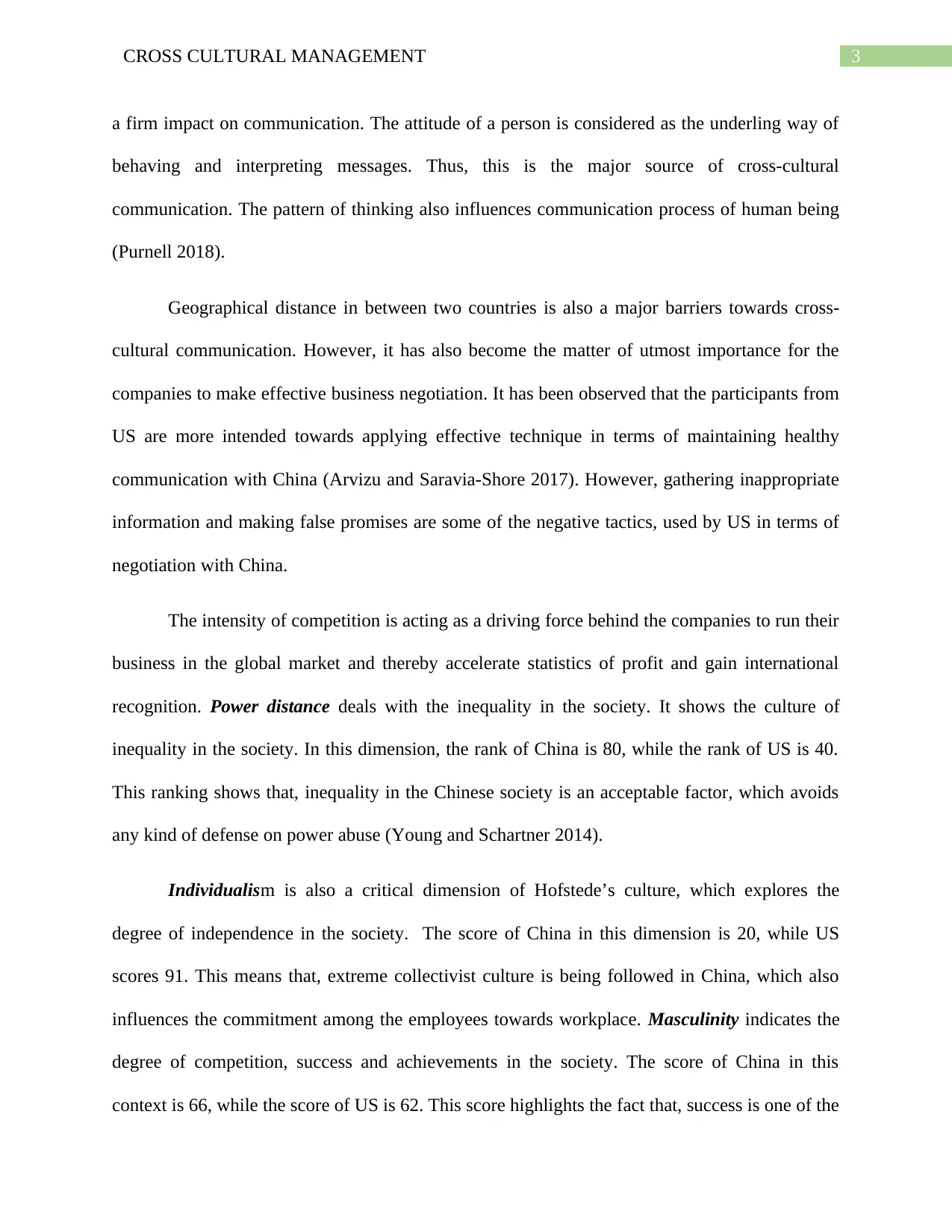
3CROSS CULTURAL MANAGEMENT
a firm impact on communication. The attitude of a person is considered as the underling way of
behaving and interpreting messages. Thus, this is the major source of cross-cultural
communication. The pattern of thinking also influences communication process of human being
(Purnell 2018).
Geographical distance in between two countries is also a major barriers towards cross-
cultural communication. However, it has also become the matter of utmost importance for the
companies to make effective business negotiation. It has been observed that the participants from
US are more intended towards applying effective technique in terms of maintaining healthy
communication with China (Arvizu and Saravia-Shore 2017). However, gathering inappropriate
information and making false promises are some of the negative tactics, used by US in terms of
negotiation with China.
The intensity of competition is acting as a driving force behind the companies to run their
business in the global market and thereby accelerate statistics of profit and gain international
recognition. Power distance deals with the inequality in the society. It shows the culture of
inequality in the society. In this dimension, the rank of China is 80, while the rank of US is 40.
This ranking shows that, inequality in the Chinese society is an acceptable factor, which avoids
any kind of defense on power abuse (Young and Schartner 2014).
Individualism is also a critical dimension of Hofstede’s culture, which explores the
degree of independence in the society. The score of China in this dimension is 20, while US
scores 91. This means that, extreme collectivist culture is being followed in China, which also
influences the commitment among the employees towards workplace. Masculinity indicates the
degree of competition, success and achievements in the society. The score of China in this
context is 66, while the score of US is 62. This score highlights the fact that, success is one of the
a firm impact on communication. The attitude of a person is considered as the underling way of
behaving and interpreting messages. Thus, this is the major source of cross-cultural
communication. The pattern of thinking also influences communication process of human being
(Purnell 2018).
Geographical distance in between two countries is also a major barriers towards cross-
cultural communication. However, it has also become the matter of utmost importance for the
companies to make effective business negotiation. It has been observed that the participants from
US are more intended towards applying effective technique in terms of maintaining healthy
communication with China (Arvizu and Saravia-Shore 2017). However, gathering inappropriate
information and making false promises are some of the negative tactics, used by US in terms of
negotiation with China.
The intensity of competition is acting as a driving force behind the companies to run their
business in the global market and thereby accelerate statistics of profit and gain international
recognition. Power distance deals with the inequality in the society. It shows the culture of
inequality in the society. In this dimension, the rank of China is 80, while the rank of US is 40.
This ranking shows that, inequality in the Chinese society is an acceptable factor, which avoids
any kind of defense on power abuse (Young and Schartner 2014).
Individualism is also a critical dimension of Hofstede’s culture, which explores the
degree of independence in the society. The score of China in this dimension is 20, while US
scores 91. This means that, extreme collectivist culture is being followed in China, which also
influences the commitment among the employees towards workplace. Masculinity indicates the
degree of competition, success and achievements in the society. The score of China in this
context is 66, while the score of US is 62. This score highlights the fact that, success is one of the
Paraphrase This Document
Need a fresh take? Get an instant paraphrase of this document with our AI Paraphraser
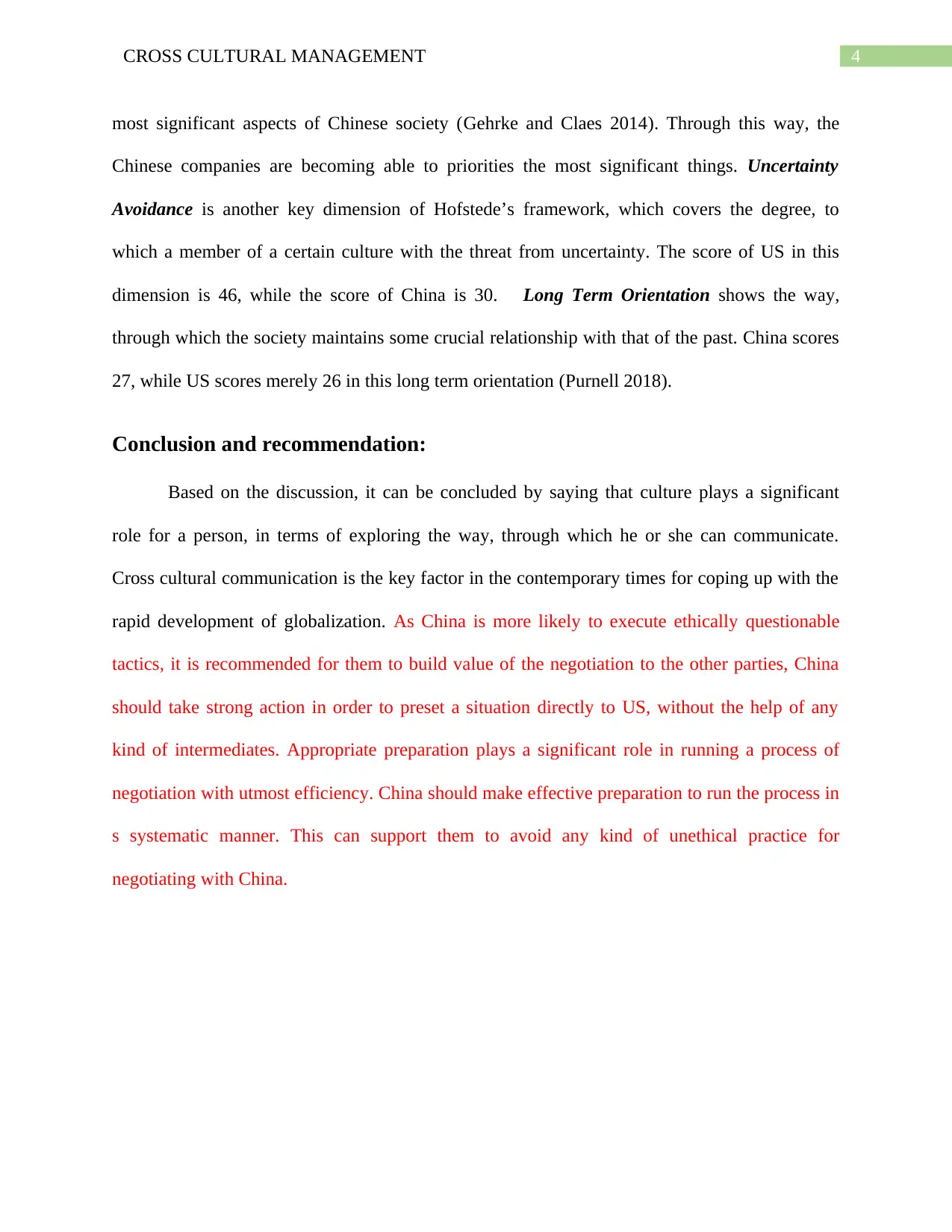
4CROSS CULTURAL MANAGEMENT
most significant aspects of Chinese society (Gehrke and Claes 2014). Through this way, the
Chinese companies are becoming able to priorities the most significant things. Uncertainty
Avoidance is another key dimension of Hofstede’s framework, which covers the degree, to
which a member of a certain culture with the threat from uncertainty. The score of US in this
dimension is 46, while the score of China is 30. Long Term Orientation shows the way,
through which the society maintains some crucial relationship with that of the past. China scores
27, while US scores merely 26 in this long term orientation (Purnell 2018).
Conclusion and recommendation:
Based on the discussion, it can be concluded by saying that culture plays a significant
role for a person, in terms of exploring the way, through which he or she can communicate.
Cross cultural communication is the key factor in the contemporary times for coping up with the
rapid development of globalization. As China is more likely to execute ethically questionable
tactics, it is recommended for them to build value of the negotiation to the other parties, China
should take strong action in order to preset a situation directly to US, without the help of any
kind of intermediates. Appropriate preparation plays a significant role in running a process of
negotiation with utmost efficiency. China should make effective preparation to run the process in
s systematic manner. This can support them to avoid any kind of unethical practice for
negotiating with China.
most significant aspects of Chinese society (Gehrke and Claes 2014). Through this way, the
Chinese companies are becoming able to priorities the most significant things. Uncertainty
Avoidance is another key dimension of Hofstede’s framework, which covers the degree, to
which a member of a certain culture with the threat from uncertainty. The score of US in this
dimension is 46, while the score of China is 30. Long Term Orientation shows the way,
through which the society maintains some crucial relationship with that of the past. China scores
27, while US scores merely 26 in this long term orientation (Purnell 2018).
Conclusion and recommendation:
Based on the discussion, it can be concluded by saying that culture plays a significant
role for a person, in terms of exploring the way, through which he or she can communicate.
Cross cultural communication is the key factor in the contemporary times for coping up with the
rapid development of globalization. As China is more likely to execute ethically questionable
tactics, it is recommended for them to build value of the negotiation to the other parties, China
should take strong action in order to preset a situation directly to US, without the help of any
kind of intermediates. Appropriate preparation plays a significant role in running a process of
negotiation with utmost efficiency. China should make effective preparation to run the process in
s systematic manner. This can support them to avoid any kind of unethical practice for
negotiating with China.
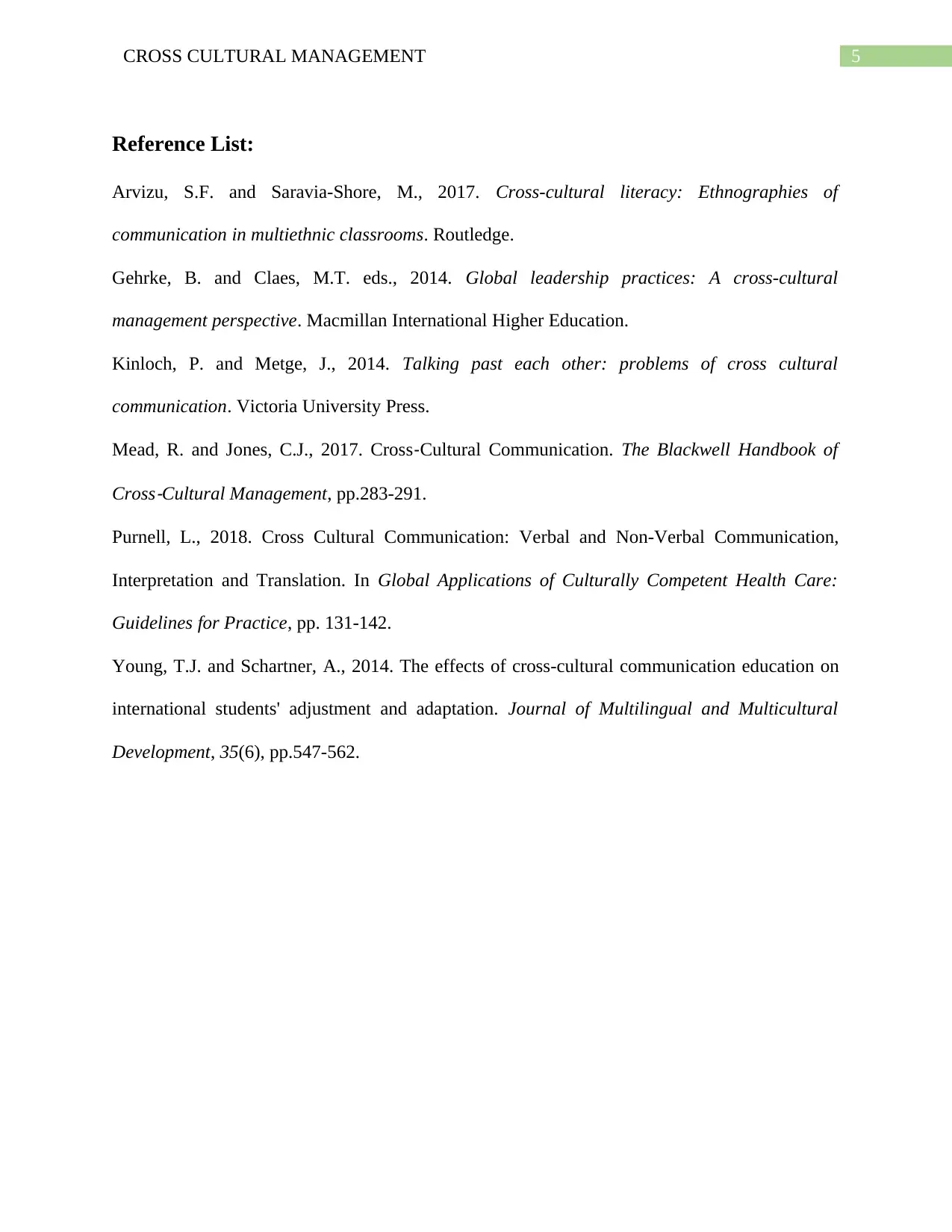
5CROSS CULTURAL MANAGEMENT
Reference List:
Arvizu, S.F. and Saravia-Shore, M., 2017. Cross-cultural literacy: Ethnographies of
communication in multiethnic classrooms. Routledge.
Gehrke, B. and Claes, M.T. eds., 2014. Global leadership practices: A cross-cultural
management perspective. Macmillan International Higher Education.
Kinloch, P. and Metge, J., 2014. Talking past each other: problems of cross cultural
communication. Victoria University Press.
Mead, R. and Jones, C.J., 2017. Cross‐Cultural Communication. The Blackwell Handbook of
Cross
‐Cultural Management, pp.283-291.
Purnell, L., 2018. Cross Cultural Communication: Verbal and Non-Verbal Communication,
Interpretation and Translation. In Global Applications of Culturally Competent Health Care:
Guidelines for Practice, pp. 131-142.
Young, T.J. and Schartner, A., 2014. The effects of cross-cultural communication education on
international students' adjustment and adaptation. Journal of Multilingual and Multicultural
Development, 35(6), pp.547-562.
Reference List:
Arvizu, S.F. and Saravia-Shore, M., 2017. Cross-cultural literacy: Ethnographies of
communication in multiethnic classrooms. Routledge.
Gehrke, B. and Claes, M.T. eds., 2014. Global leadership practices: A cross-cultural
management perspective. Macmillan International Higher Education.
Kinloch, P. and Metge, J., 2014. Talking past each other: problems of cross cultural
communication. Victoria University Press.
Mead, R. and Jones, C.J., 2017. Cross‐Cultural Communication. The Blackwell Handbook of
Cross
‐Cultural Management, pp.283-291.
Purnell, L., 2018. Cross Cultural Communication: Verbal and Non-Verbal Communication,
Interpretation and Translation. In Global Applications of Culturally Competent Health Care:
Guidelines for Practice, pp. 131-142.
Young, T.J. and Schartner, A., 2014. The effects of cross-cultural communication education on
international students' adjustment and adaptation. Journal of Multilingual and Multicultural
Development, 35(6), pp.547-562.
⊘ This is a preview!⊘
Do you want full access?
Subscribe today to unlock all pages.

Trusted by 1+ million students worldwide
1 out of 6
Related Documents
Your All-in-One AI-Powered Toolkit for Academic Success.
+13062052269
info@desklib.com
Available 24*7 on WhatsApp / Email
![[object Object]](/_next/static/media/star-bottom.7253800d.svg)
Unlock your academic potential
Copyright © 2020–2025 A2Z Services. All Rights Reserved. Developed and managed by ZUCOL.




